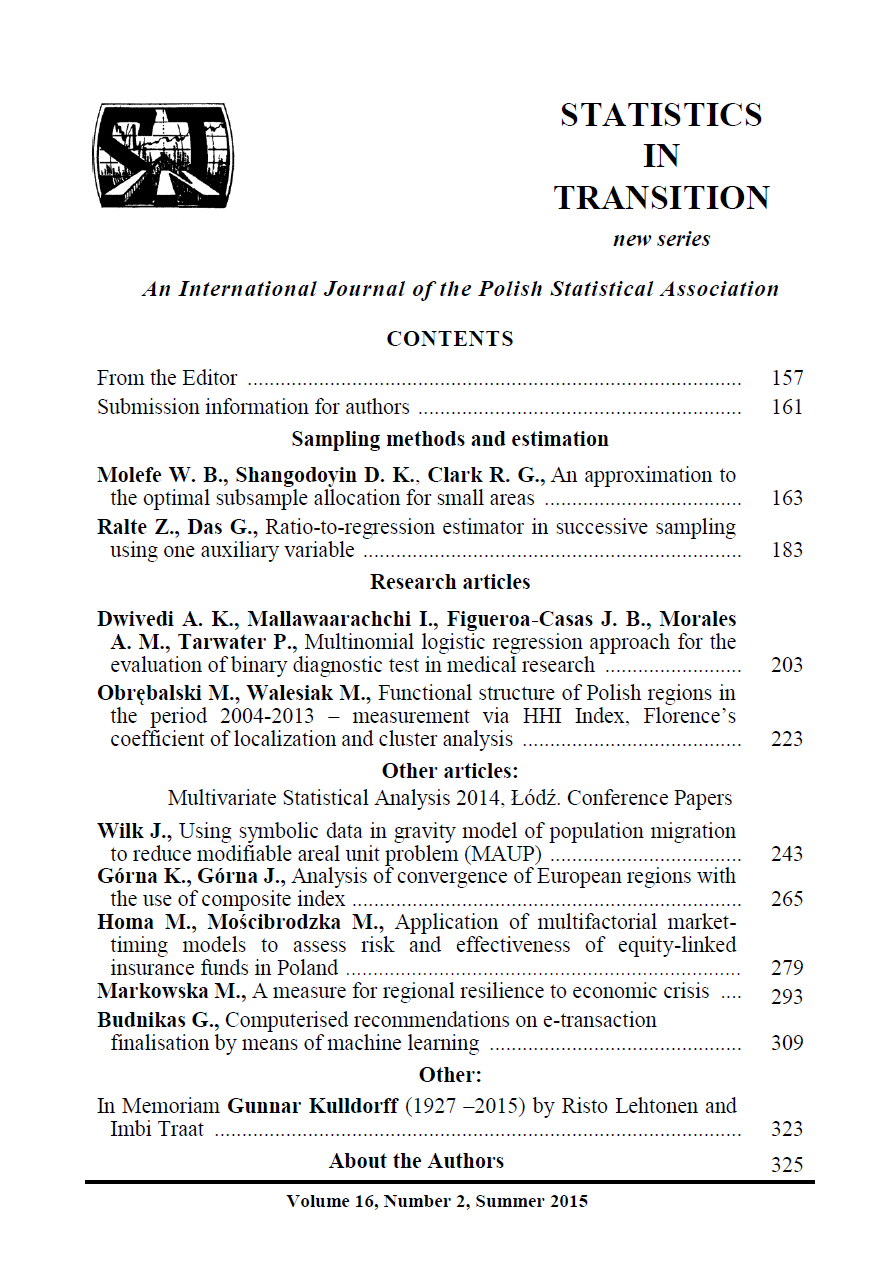ARTICLE
ABSTRACT
The problem of estimation of finite population mean on the current occasion based on the samples selected over two occasions has been considered. In this paper, first a chain ratio-to-regression estimator was proposed to estimate the population mean on the current occasion in two-occasion successive (rotation) sampling using only the matched part and one auxiliary variable, which is available in both the occasions. The bias and mean square error of the proposed estimator is obtained. We proposed another estimator, which is a linear combination of the means of the matched and unmatched portion of the sample on the second occasion. The bias and mean square error of this combined estimator is also obtained. The optimum mean square error of this combined estimator was compared with (i) the optimum mean square error of the estimator proposed by Singh (2005) (ii) mean per unit estimator and (iii) combined estimator suggested by Cochran (1977) when no auxiliary information is used on any occasion. Comparisons are made both analytically as well as empirically by using real life data.
KEYWORDS
ratio-to-regression estimator, auxiliary variable, successive sampling, bias, mean square error, optimum replacement policy.
REFERENCES
CENSUS OF INDIA, (2001). www.cesusindiagov.in.
CENSUS OF INDIA, (2011). www.cesusindiagov.in.
COCHRAN, W. G., (1977). Sampling Techniques. Third edition. Wiley Eastern Ltd.
DAS, A. K., (1982). Estimation of population ratio on two occasions. Journal of the Indian Society of Agricultural Statistics. 34: 1-9.
GUPTA, P. C., (1979). Sampling on two successive occasions. Journal of Statistical Research. 13: 7-16.
PATTERSON, H. D., (1950). Sampling on successive occasions with partial replacement of units. Journal of the Royal Statistical Society. 12(B): 241-255.
RAO, J. N. K., GRAHAM J., E., (1964). Rotation designs for sampling on repeated occasions. Journal of American Statistical Association. 59: 492-509.
SEN, A. R., (1971). Successive sampling with two auxiliary variables. Sankhya. 33(B): 371-378.
SEN, A. R., (1972). Successive sampling with pp 1 auxiliary variables, The Annals of Mathematical Statistics. 43: 2031-2034.
SEN, A. R., (1973). Theory and application of sampling on repeated occasions with several auxiliary variables. Biometrics. 29: 381-385.
SINGH, G. N., (2003). Estimation of population mean using auxiliary information on recent occasion in h occasions successive sampling. Statistics in Transition. 6(4): 523-532.
SINGH, G. N., (2005). On the use of chain-type ratio estimator in successive sampling. Statistics in Transition. 7(1): 21-26.
SINGH, G. N., PRIYANKA, K., (2006). On the use of chain-type ratio to difference estimator in successive sampling. International Journal of Applied Mathematics and Statistics. 5(S06): 41-49.
SINGH, G. N., PRIYANKA, K., (2007). On the use of auxiliary information in search of good rotation patterns on successive occasions. Bulletin of Statistics and Economics. 1(A07): 42-60.
SINGH, G. N., PRIYANKA, K., (2008). On the use of several auxiliary variates to improve the precision of estimates at current occasion. Journal of the Indian Society of Agricultural Statistics. 62(3): 253-265.
SINGH, G. N., SINGH, V. K., (2001). On the use of auxiliary information in successive sampling. Journal of the Indian Society of Agricultural Statistics.54(1): 1-12.
SINGH, H. P., VISHWAKARMA, G. K., (2007). A general class of estimators in successive sampling. Metron. LXV(2): 201-227.
SINGH, P., TALWAR, H. K., (1991). Estimation of population regression coefficient in successive sampling. Biometrical Journal. 33: 599-605
